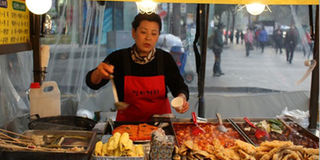History, culture define Seoul

Kimch’l is the national dish which is mixture of fermented spicy vegetables often served hot
What you need to know:
WOW. The soul and the spirit of South Korea are inexpressible when you visit a country full of culture and ancient history as Lominda Afedraru finds out.
South Korea is known for its ancestral dynasty background with the last two dynasties of Koryo and Choson as the last known that existed until the year 1910.
The country is mountainous with the southern part being a flat land where a few nationals are practicing agriculture, mainly rice growing.
Upon touching base, one could mistake Incheon International Airport for Entebbe Airport because it is surrounded by a water body from River Hangang which surrounds Seoul.
It takes an hour-long bus ride from the airport to Seoul. You go through a road network which runs close to the river and is crisscrossed by about 26 bridges connecting the city from corner to corner.
Most multinationals living in Seoul are based in the Gangnam District. Gangnam means south of river Hangang and it comprises multinational companies, financial businesses, language institutes and internationals Universities.
To enjoy a meal in Seoul
When it came to culinary delights, Kimch’l is the national dish which is mixture of fermented spicy vegetables often served hot. Almost any vegetable can be fermented to make kimch’I but Chinese cabbage and daikon radish are common as well.
As part of the national diet for centuries, it has many variations depending on the region, season, occasion, and personal taste of the cook.
Kimch’I has long been the test of a housewife’s cooking skills and a family tradition. A South Korean consumes an average of 40 pounds (about 18 kilogrammes) of kimch’I a year. Many companies produce kimch’I for both domestic consumption and export.
Meat dishes such as barbecued meat and short ribs; beef and pork is popular among South Koreans and foreigners. They are traditionally charcoal roasted after the meat has been marinated in soy sauce, sesame oil, sugar, minced garlic, and other spices. The foods available at restaurants range from sophisticated Western cuisine to various ethnic specialty foods, to both indigenous and foreign fast foods. There are no food taboos, although Buddhist monks may practice vegetarianism and observe other food taboos.
The magnificent architecture
Traditionally, South Koreans believe in dwellings with thatched roof and houses with clay tile roofs symbolising rural and urban as well as lower class and upper class distinctions. The traditional houses of yangban (elite) families were divided by walls into women’s quarters and men’s quarters called anch’ae.
Janice Chai, a tour guide at the Korean Tourism Organisation, says the World Trade Centre commonly known as COEX hosts a number of activities since it is surrounded with prestigious hotels.
This building complex in Samseong don, Gangnam District. It houses the ASEM Tower, the Trade Tower, and COEX Intercontinental Seoul Tower with shopping malls with various mercantile. Luckily, the World Conference of Science Journalists which usually gathers all science journalists and scientists globally after every two years was this year hosted in this complex, the first of its kind in one of the Asian countries.
Chai explains that usually global meetings are held in this complex where guests are treated to entertained by the Korean wave music consisting of dance and drama using their traditional attire called Hambo.
Mainly citizens from Japan, China, Malaysia are attracted to the traditional dance but who was excited this time round to see African Journalists getting involved in this kind of meeting.
“I am so excited to see Africans in their traditional attire made out of fine cotton and well designed. I use to think it is only Nigerians who put on this traditional attire but I am glad to know almost all Africans embrace this attire. I am so glad that I now have African friends with whom I can interact anytime on social media,” She explained.
At the temple
Jin Haeyin, a volunteer working at one of the ancient Buddhist Temples, Bongeunsa is so excited to see journalists from different parts of the world coming to the temple.
“This is Bongeunsa temple which has existed over the last 1,200 years, located in Gangnam- gu, Seoul. It was constructed during the reign of King Wonseoung led by the national teacher Ven Yeonhoe who became the head of the temple of the Seon sect during the Joseon Dynasty. This temple is represented by Sekyan Bhudha in the centre of the hall flanked on either side by Amitabha Budha and the Medicine Bhudha who is the heart of the temple. Usually many believers bow before the Medicine Budha in order to get healing,” Jin explains.
She explains that about 25 per cent of the South Korean population comprise of Buddhist believers, 20 per cent Catholics, five per cent belonging to the rest of the religious sects and 20 per cent are non-believers.
Most of the country’s investments focus on science technology and engineering with little agricultural activity going on. The country is known for importing food from other neighbouring countries because what is grown mainly in the country is rice and some vegetables grown in green houses.
Fun
The youth, children and their parents enjoy hanging out at the Beach of Hangang River, which comprises playing facilities, bicycle-riding lanes, food and drinking stores .




